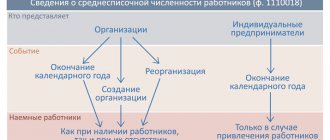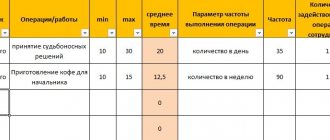Why do you need to count payroll numbers?
As stated above, the value under consideration implies the total number of employees of the enterprise.
If we talk about its practical significance, then the payroll number of employees of an enterprise is a test number that helps in solving analytical problems, such as assessing labor efficiency, calculating average wages and staff turnover rates. In addition, the column of the same name is present in a number of reports submitted to regulatory authorities. For example, information on the payroll number of employees is reflected in form 4-FSS, approved by Order of the Social Insurance Fund of the Russian Federation dated September 26, 2016 No. 381. In addition, the specified coefficient is taken as the basis for another value - the average payroll composition of personnel. It, in turn, is necessary when filing tax returns electronically (clause 3 of Article 80 of the Tax Code of the Russian Federation), when calculating income tax at the location of a separate division (clause 2 of Article 288 of the Tax Code of the Russian Federation) or when filling out the DAM form -1 Pension Fund. https://youtu.be/0rR_R-Wch_I
Let's move on to the calculations
The average number of employees per month is equal to the sum of the number of employees for each calendar day of the month, divided by the number of calendar days in the month.
Please note: the calculation takes into account holidays (non-working days) and weekends. The number of employees for these days is equal to the payroll number for the previous working day. Moreover, if weekends or holidays span several days, then the payroll number of employees for each day will be the same and equal to the payroll number for the working day preceding the weekend or holiday. This condition is contained in paragraph 87 of the Resolution.
Example 1. LLC “Kadry Plus” employs 25 people under employment contracts. The established work schedule is a 40-hour, five-day work week. The headcount as of November 30 was 25 people.
From December 3 to December 16 inclusive, employee Ivanov went on his next annual paid leave.
On December 5, accountant Petrova went on maternity leave. To fill this position, from December 10, employee Sidorov was hired on the basis of a fixed-term employment contract.
From December 10 to December 14 inclusive, student Kuznetsov was sent to the company for practical training. No employment contract was concluded with him.
On December 18, 19 and 20, 3 people (Alekseeva, Bortyakova and Vikulov) were hired under an employment contract with a probationary period of two months.
On December 24, driver Gorbachev submitted his resignation and did not return to work the next day.
It is necessary to calculate the average number of employees for December.
Weekends and holidays in December were the 1st, 2nd, 8th, 9th, 15th, 16th, 22nd, 23rd, 30th, 31st. Therefore, on these days the payroll number of employees will be equal to the payroll for the previous working days. That is, this figure on December 1 and 2 will be equal to the payroll number for November 30, December 8 and 9 - for December 7, and so on.
Of the workers listed above, the December payroll will include:
- Ivanov - from December 1 to December 31,
- Petrova - from December 1 to December 31,
- Sidorov - from December 10 to 31,
- Alekseeva - from December 18 to 31,
- Bortyakova - from December 19 to 31,
- Vikulov - from December 20 to 31,
- Gorbachev - from December 1 to December 24.
Petrov’s accountant is not taken into account in the average headcount (from December 5). And student Kuznetsov is not included in the payroll at all, since he does not hold any position in the company.
For clarity, let’s draw up a table that defines the payroll for December 2007:
The number of employees of LLC "Kadry Plus" in December 2007
| Day of the month | Headcount, people. | Of these, they are not included in the average headcount, people. | Included in the average headcount, people. (gr. 2 - gr. 3) |
| 1 | 2 | 3 | 4 |
| December 1 (day off) | 25 | 0 | 25 |
| December 2 (day off) | 25 | 0 | 25 |
| December 3 | 25 | 0 | 25 |
| December 4 | 25 | 0 | 25 |
| 5th of December | 25 | 1 | 24 |
| December 6 | 25 | 1 | 24 |
| December 7 | 25 | 1 | 24 |
| December 8 (day off) | 25 | 1 | 24 |
| December 9 (day off) | 25 | 1 | 24 |
| December 10 | 26 | 1 | 25 |
| December 11th | 26 | 1 | 25 |
| 12 December | 26 | 1 | 25 |
| December 13th | 26 | 1 | 25 |
| December 14 | 26 | 1 | 25 |
| December 15 (day off) | 26 | 1 | 25 |
| December 16 (day off) | 26 | 1 | 25 |
| December 17 | 26 | 1 | 25 |
| December 18 | 27 | 1 | 26 |
| December 19th | 28 | 1 | 27 |
| 20th of December | 29 | 1 | 28 |
| 21 December | 29 | 1 | 28 |
| December 22 (day off) | 29 | 1 | 28 |
| December 23 (day off) | 29 | 1 | 28 |
| December 24 | 29 | 1 | 28 |
| December 25 | 28 | 1 | 27 |
| September 26 | 28 | 1 | 27 |
| 27th of December | 28 | 1 | 27 |
| December 28th | 28 | 1 | 27 |
| December 29th | 28 | 1 | 27 |
| December 30 (day off) | 28 | 1 | 27 |
| December 31 (day off) | 28 | 1 | 27 |
| Total | 802 |
Let's calculate the average headcount for December:
802 person-days : 31 days = 25.87 people
In whole units it will be 26 people.
The rules for calculating the average number of employees for a quarter, year or other period are as follows: it is necessary to add up the average number of employees for each month of the period and divide by the number of months. For example, if you want to know the indicator for a quarter, then you need to divide by 3, if for a year - by 12. In this case, the indicator obtained for the month should not be rounded to whole units. Only the final result of the average headcount for the billing period is subject to rounding.
How to calculate
Calculation of the corresponding coefficient involves the question of who is included in the payroll number of employees. The answer is contained in the Instructions on statistics of the number and wages of workers and employees at enterprises, institutions and organizations, approved by the State Statistics Committee of the USSR on September 17, 1987. According to clause 2.9 of the specified document, the list of employees of the enterprise includes “all employees hired for permanent, seasonal, and also temporary work for a period of one day or more, from the day they are hired.” It should be understood that the number of employees present and on the payroll are different quantities. The latter includes not only employees present at the workplace, but also some of the personnel who did not show up for reasons such as downtime, being on a business trip, illness, annual leave, etc. The full list is determined by clause 77 of the Instructions, approved by order of Rosstat dated 22.11. .2017 No. 772.
What is the difference between payroll and regular numbers?
The law does not contain such a thing as “staffing”. However, this term is used in practice. It denotes the number of workers specified in the staffing table of the enterprise. That is, this is the number of occupied and vacant positions.
The headcount is the number of employees with whom the employer has entered into employment agreements. In this case, the duration of the contract or actual presence at the workplace are not important.
Staffing is a broader concept. The manager has the right to set staffing levels in accordance with his needs and wishes. In this case, you need to be guided by the expected level of productivity and scale of production.
Who is excluded from the calculation
As stated above, the payroll includes employees who have entered into labor relations with the enterprise, regardless of their nature and duration. In accordance with paragraph 79 of the Rosstat Instructions mentioned above, the following employees are not included in the payroll:
- hired externally;
- working under civil contracts;
- enterprises working under special agreements with government services to attract labor (military personnel and persons serving sentences);
- transferred to work in another organization;
- aimed at training without work and without pay;
- those who submitted a letter of resignation and stopped working before the expiration of the warning period or stopped working without warning;
- lawyers;
- military personnel in the performance of military service duties.
Definition
The staffing number is divided into several standards, these are:
- population norm (NP);
- payroll number (SC);
- turnout number (NA).
Two main indicators, such as the list and attendance of workers, do not have equal calculation features and purposes of use.
The standard number of personnel is a standard established in accordance with the professional and qualification number at the enterprise, which is necessary to provide a certain volume of services. Thanks to it, you can calculate production costs for professional activities, specialties and groups of work, as well as for the organization as a whole or individual branches. This value is one of the most important components of all standards. It is calculated in accordance with such data as the nuclear force, the average number and the average number.
The list value is the value of the personnel structure at the enterprise, calculated for the corresponding period of time, taking into account all employed citizens, including seasonal, main (permanent), remote, etc. Also included are owners registered under an employment contract, who are paid for the performance of their official duties. Persons employed under civil law agreements and contract agreements are excluded from the payroll structure. The calculation is made for each calendar day, regardless of non-working days (holidays and weekends), both those actually present at the work place, and those absent due to some circumstances (business trips, customer service outside the company, vacations, sick leave, maternity leave, etc.) .
Attendance is a standard that determines the number of officially employed persons from the secondary sector who actually appeared at their official place on a certain working day, including employees on business trips. It allows you to establish the dynamics of the production process. The discrepancies in the standards of the SC and the JSC characterize the number of employees who, due to certain circumstances, are not at their official place.
For the ratio of the number of employees to the number of employees, the coefficient for converting the number of workers present to the payroll (K sp) is used; the formula is contained in the regulatory provisions of the Guidelines for the preparation of statistical reporting.
In industries where work interruptions predominate, the conversion factor is determined by the formula:
K sp = N in / P in, where
N in – nominal time, that is, actually worked;
P in – planned time, that is, the time calculated to obtain maximum production efficiency.
For the inverse ratio, the following calculation method is used:
Ch i = Ch sp / K sp, where
Ch sp – payroll number.
Or to convert values, the following formula applies:
H i = H sp / (1/K sp).
When making calculations, it should be remembered that the average number always exceeds the turnout by the number of absent citizens.
Headcount
What are the differences from the average
As we previously found out, the number of employees on the payroll is the number of people who have entered into an employment relationship with the organization in the form of an employment contract. This value is calculated for each day in whole units and corresponds to the number of people declared on the working time sheet. The resulting indicator is taken as the basis for calculating the average headcount, a significant value for statistics and taxation. Its calculation for a month is carried out as a calculation of the average value: the average value for each calendar day is summed up, the resulting amount is divided by the number of calendar days. The quarterly coefficient is calculated in a similar way. However, in order to obtain correct data when calculating both quantities, it is necessary to take into account a number of nuances.
Conversion factor from turnout to payroll
Using the coefficient for converting the number of employees to the payroll, the need to increase the number of employees to replace temporarily absent workers due to vacation, disability and other circumstances is calculated. This is necessary for competent personnel management, because using relevant data, the enterprise's need to recruit new employees is determined.
The attendance number of main workers per day Rav/day is determined by the formula:
Ryav/day = M x C, (9)
where M is the number of jobs for this category, pcs.,
C - number of shifts depending on the shift schedule, pcs.
Staffing number of main production workers Rsht people. determined by the formula:
Rsht = Ryav/day + substitution, (10)
where Rav/day is the number of attendance per day, people.
The coefficient of reduction of staffing levels and payroll numbers of the Kpr is determined by the formula:
Kpr = Tnom / TEf, (11)
where Tnom is the nominal working time fund, in days,
Teff is the effective fund of working time in days.
The payroll number of main production workers Rsp people. determined by the formula:
Rsp = Rsht x Kpr, (12)
where Rsht is the staffing number of main workers, people,
Kpr - staffing reduction factor, people.
The turnout is calculated using formula 9:
Ryav/day = 3 x 1 = 3 people.
The staffing number of key production workers is determined as the number of attendance per day plus substitution:
Rst = 3 + 1 = 4 people.
The coefficient for bringing the regular number of workers to the payroll number of the Kpr is determined for the transition of the regular number of workers to the payroll number, it will be:
Kpr = 277/241 = 1.15
Let's determine the headcount:
Rsp = 4 x 1.15 = 5 people.
We summarize the obtained data in a table5
Table 5 - Turnout, staffing and payroll numbers of main production workers.
| Name of specialties | Shift schedule | Shift duration | Tariff category | Turnout number of workers in | Number of replacement workers | Staffing number of workers, Rsht | Reduction coefficient and headcount | List number of workers | |
| 1 Operator | |||||||||
| 2 Decomposition operator | |||||||||
| 3 Decomposition operator | |||||||||
| 4 Cooking operator | |||||||||
| 5 Cooking operator | |||||||||
| 6 Dosing operator | |||||||||
| 7 Dosing operator | |||||||||
| 8 Neutralization operator | |||||||||
| 9 Pumping unit operator | |||||||||
| 10 Drying operator | |||||||||
| 11 Drying operator | |||||||||
Status, problems and prospects for further development of the land market in Russia In Russia, the creation of the foundations of a market economy has been completed, and world society has recognized it as a market country. However, recurring global economic crises and a number of subjective reasons...
Risk in pricing and price insurance The goal of entrepreneurship is to obtain maximum income at minimum costs in a competitive environment. When carrying out any type of economic activity, objectively...
Organization of effective work of the planning and economic department of the enterprise. Formation of efficiency criteria In a market economy, the sustainability and success of any enterprise can only be ensured by effective planning of its economic activities. Planning functions in such...
When planning, a distinction is made between turnout, payroll and average number of workers.
The attendance number refers to the number of workers who must be at their workplaces every day in the planned period.
The payroll number is the number of workers required for continuous operation of the equipment, taking into account the replacement of the main staff of workers during regulated breaks. The payroll includes all permanent, temporary and seasonal workers who are hired for more than five days.
The average number of employees is determined by dividing the total number of employees on the list for each calendar day, not excluding weekends and holidays, by the calendar number of days in the period.
When calculating the number of workers present, two methods are used:
- standard hours method;
method of assigning workers to work stations.
The first method is used to calculate the number of workers performing work, the volume of which can be accounted for and measured in natural units or man-hours.
This method calculates the number of workers involved in maintenance, current and major repairs of equipment, workers in repair and restoration and construction teams, workers in derrick installation teams, workers in underground and overhaul well repair teams, and the number of workers involved in loading and unloading operations. These are mechanics of various specialties, electric and gas welders, tower fitters, electricians, and construction workers.
When calculating the number of workers using the standard hour method, they proceed from the norms of time spent on each operation and the list of operations or from the norms of time spent on a set of works on maintenance and repair of equipment. Based on these data, the labor intensity of the planned amount of work in standard hours is determined.
The number of workers present using the standard hour method is calculated using the formula:
where T is the labor intensity of the planned volume of work in standard hours (man-hours);
F ef. – effective working time fund of one worker in the planning period, hours;
B – planned percentage of standards fulfilled, %.
If there are production standards, the number of workers present is calculated using the formula:
(2.11)
where О is the planned volume of work in physical terms;
N vyr. - production rate.
If time standards are available, the number of workers present is calculated using the formula:
(2.12)
where N vr. - time norm.
Standard time
- this is the amount of time established for the performance of a particular work by one worker or a group of a certain number and qualifications in the given organizational and technical conditions of production. The time standard is set in hours, minutes, seconds.
Production rate
- this is the amount of production or the amount of work in natural units that must be performed per unit of time by one or more workers in the given organizational and technical production conditions. The value of the time norm.
The method of assigning workers to workplaces is used when planning the number of workers servicing technological installations, wells, gas compressor stations, pumping, gas pumping units, and drilling rigs. The work of these workers is regulated by technological maps for servicing workplaces, staffing standards and service standards. This method is used to calculate the availability of gas compressor station operators, oil and gas production operators, the number of drilling crew workers, thermochemical plant operators, gas pumping unit operators, instrumentation and automation mechanics.
The number of workers present using this method is calculated using the formula:
(2.13)
(2.14)
where M is the number of jobs;
N – population norm;
P cm – number of work shifts per day;
N o – standard of service.
Number of people
workers is expressed in the number of workers of a certain professionally qualified composition necessary to perform a given job or to service certain objects in a certain unit of working time in the given organizational and technical conditions of production.
Standard of service
- this is the number of units of equipment, units, installations that must be serviced by one or a group of workers in a certain unit of working time in the given organizational and technical production conditions.
The turnout number of drilling crew workers is calculated using formula 2. The norm for the number of workers on a drilling shift depends on the type of drilling rig. The calculation of workers is made separately according to the professions of workers included in the drilling shift: driller, driller's assistant, etc.
The payroll number of workers is determined taking into account the replacement of the main composition of workers during regulated breaks. The payroll number of workers consists of those who showed up for work on a given day and those who did not show up due to vacations, illness, performance of government duties and other absences from work permitted by law, but included in the list of the enterprise, i.e. The payroll includes all permanent, seasonal and temporary workers for whom the administration has established work books.
The coefficient for converting attendance to payroll (replacement coefficient, payroll coefficient, worker loss coefficient) for continuous production is determined by the formula:
(2.15)
where F cd is the calendar fund of time for one worker in the planning period, days; F ef. — effective time fund of one worker in the planning period, days.
For continuous production, this coefficient is determined by the formula:
(2.16)
where F nom. – nominal time fund of one worker in the planning period, days.
The calendar time fund is equal to the number of calendar days in the planning period. The nominal working time fund is less than the calendar one by the number of days off (for continuous production) and weekends and holidays (for continuous production). The nominal working time fund cannot be used in full, since workers have annual vacations and other breaks in working time provided for by labor legislation.
The effective working time fund is the maximum number of days (hours) that can be worked by one worker per year. The effective working time fund is determined by subtracting from the nominal working time fund the days of absence from work planned on the basis of labor legislation: regular and additional leaves, educational leaves, maternity leave, absences due to illness and other absences permitted by law (performance of government duties, etc.) .).
To calculate the nominal and effective funds, a balance of the working time of one worker is drawn up.
The calculation of the working time balance of one worker working a five-day workweek and one worker working three eight-hour shifts per day is given in Table 2.3.
Workers of drilling crews most often in all regions of the Russian Federation work on a four-shift shift schedule with two twelve-hour shifts with a shift period of 28 days.
Four-shift shift schedule with three eight-hour shifts
| Days of the month | ||||||||||||||||
| 1st shift | ||||||||||||||||
| 2nd shift | ||||||||||||||||
| 3rd shift | ||||||||||||||||
A, B, C, D – workers of the drilling crew.
The average monthly working time for one worker according to the shift schedule is calculated using the formula:
(2.17)
where F cd is the calendar fund of time for one worker, days;
T r.d. – number of months in a year (assumed to be 12);
N r – number of workers according to the shift schedule, people.
The number of days off per worker is calculated using the formula:
(2.18)
where D in is the number of days off in one shift per worker, days;
P s – shift period, days.
According to a four-shift shift schedule with two twelve-hour shifts, the average monthly working time of one worker is determined (calculated) by the formula:
Number of days off per worker according to this shift schedule:
After these calculations, a balance of working time for one worker is drawn up.
Table 2.3
Balance of working time of one worker
| Elements of time | Day workers | Shift workers |
| Calendar time fund, days | ||
| Weekends and holidays | ||
| Nominal working hours, days | ||
| Absence from work, days | ||
| Including: | ||
| Next holidays | ||
| Additional holidays | ||
| Study leaves | ||
| Maternity leave | ||
| Absenteeism due to illness | ||
| Other absences permitted by law (performance of government duties, etc.) | ||
| 5. Effective working time fund, days | ||
| 6. Average working day, hour. | ||
| 7. Effective working time fund, hour. |
The planned number of days of absenteeism is determined by calculation and using static data. The calculation determines the duration of regular, additional leave, study leave and maternity leave.
The duration of the next vacation (similarly to other vacations) is calculated using the formula:
(2.19)
where Ch 1, Ch 2, ... Ch p is the average number of workers of the nth category in this division of the enterprise at the beginning of the year;
D 1, D 2, ... D p – the duration of leave for workers of the nth category established by labor legislation.
To determine the total duration of vacations in connection with studies, it is necessary to divide the total duration of all student vacations by the payroll number of workers in the workshop or enterprise.
The number of days of maternity leave per average worker depends on the number of maternity leaves in the reporting year, the duration of one leave and the share of women in the total number of workers.
Absenteeism from work in connection with the performance of government duties is accepted at the level of the reporting period; absenteeism due to illness for the past period is adjusted taking into account the improvement of sanitary and hygienic conditions, medical care, housing and cultural conditions.
The planned number of specialists is accepted according to the approved staffing table. The staffing table is based on the standards for the number of specialists. Standards for the number of specialists are calculated by management functions, taking into account factors influencing the level of the standard. The number of specialists in the enterprise is determined by summing up the headcount standards for management functions. The need for specialists is calculated based on the turnout.
The turnout number of drilling crew workers is calculated by the method of assigning workers to jobs. Calculation of the attendance and payroll number of drilling crews must be performed in Table 2.4.
Table 2.4
Calculation of the number of working drilling crews.
| Name of profession | Hourly tariff rate, rub. | Number of workers in | Calculation formula |
| Driller | M x 1 x P cm x K p M x 1 x P cm x K p | ||
| Assistant driller (first, second and third) | M x 1 x P cm x K p M x 1 x P cm x K p M x 1 x P cm x K p | ||
| Motor operator (diesel operator) of a drilling rig | M x 1 x P cm x K p | ||
| Drilling equipment maintenance mechanic | M x 1 x P cm x K p | ||
| Senior diesel operator | M x 1 x P cm x K p |
Number of drilling rigs in drilling (M):
(2.20)
where T b – calendar drilling time, st.-month.
Number of employees – the number of workers at a particular enterprise. The number can be turnout, payroll, average payroll. This indicator is used when analyzing the efficiency of using working time, calculating personnel costs and determining personnel requirements, as well as when submitting reports to Rosstat.
Where do maternity leave belong?
It was demonstrated above that the procedure for calculating the quantitative characteristics of personnel is quite simple. Confusion arises, as a rule, due to the existence among the staff of those who are included in the number of employees on the payroll, but are not included in the average payroll. This applies, for example, to such a category as women (in some cases men) on parental leave. Are maternity leavers included in the payroll? An affirmative answer to this question is given by clause 77 of the Rosstat Instructions (approved by Rosstat Order No. 772 dated November 22, 2017). However, clause 79.1 of the same document states that this category of workers is not included in the average. The rule also applies to persons studying or entering an educational institution while on leave without pay.
Which employees are included in the list?
The list includes these specialists:
- Employees who actually reported to the place of duty.
- People who are on business trips. If the business trip is foreign, then inclusion in the list depends on the duration of the event. If it is short-term, the employee is included in the list. If the business trip is long-term, then the employee is not included in the list.
- Persons who are absent from the workplace on sick leave.
- Persons performing public or government functions.
- Persons who work part-time but are enrolled as a whole unit.
- Persons working from home.
- Those on probation.
- Temporary employees who replace the main ones until the latter return to work.
- Employees sent on vacation.
- Persons undergoing training at a vocational school, but who are registered with the company.
- Persons temporarily involved in agricultural work, if earnings from their main job are maintained.
- Employees working on a rotational basis.
- Women who went on leave due to BiR.
- Those who have reached retirement age.
- Foreign persons employed in a Russian company.
- Persons under investigation awaiting a court decision.
IMPORTANT! All of the above categories of employees are included in the list from the date the employment contract comes into force. If workers carry out their activities without an agreement at all, they will not appear on the lists.
FOR YOUR INFORMATION! There is also such a thing as turnout numbers. It represents the number of employees who reported to work on a given day. This list also includes those employees who are on business trips.
Nuances and difficulties
In addition to persons on maternity leave, there are other categories of employees that cause controversy when calculating staff numbers. For example, the question often arises whether the owners of the enterprise are included in the SC. According to paragraph 77 of the Rosstat Instructions (approved by Rosstat Order No. 772 dated November 22, 2017), the answer to this question is affirmative, provided that the owners worked and received wages. Paragraph 78 of the document also contains commentary regarding internal part-time workers. Each of them is counted as one person in the account balance. As for persons who have an employment contract and a work contract with the organization at the same time, they, in accordance with paragraph 78 of the Instructions, are taken into account in the SCH and SSC once at their main place of work.










